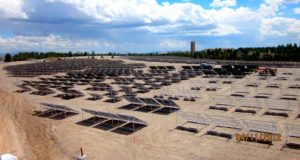
The Los Alamos Department of Public Utilities (DPU) is a leader in environmental innovation among utility companies, including renewable power generation and smart grid development. The DPU produces over 30 percent of its electricity from renewable sources and is partnering with major international corporations, Japan's New Energy and Industrial Technology Development Organization (NEDO) through the Japanese Ministry of Technology and Los Alamos National Laboratory on the development of new renewable energy battery storage technology and smart grid and smart house applications.
DPU was selected from among dozens of New Mexico utility companies to host two important research projects. The first entailed the testing of solar energy battery storage systems developed by major global corporations headquartered in Japan. The theory is that these systems will become cost-effective means to collect and store solar energy for nighttime use. The second project entailed the construction of a smart home to test appliances and systems that work with the electrical grid to optimize energy use and efficiency. Both of the NEDO demonstration projects and DPU’s own low flow hydro-electric plant are attracting worldwide interest for the “real world” application of innovative energy systems into a working utility company.
For two years American and Japanese partners have toiled together to build the Demonstration Smart Grid in Los Alamos which demonstrates how to provide a significant proportion of renewable energy on the electric grid to meet a community’s residential needs. The Demonstration Smart Grid project includes 2 megawatts of photovoltaic power (1 megawatt is built by NEDO; another megawatt is to be built by Los Alamos DPU), 8.3 megawatt hours of batteries, a micro energy management system, and a smart house which includes smart appliances that allow for electric demand in the house to be responsive to smart grid signals, minimizing potential costs and preserving the comfort of residential usage patterns.